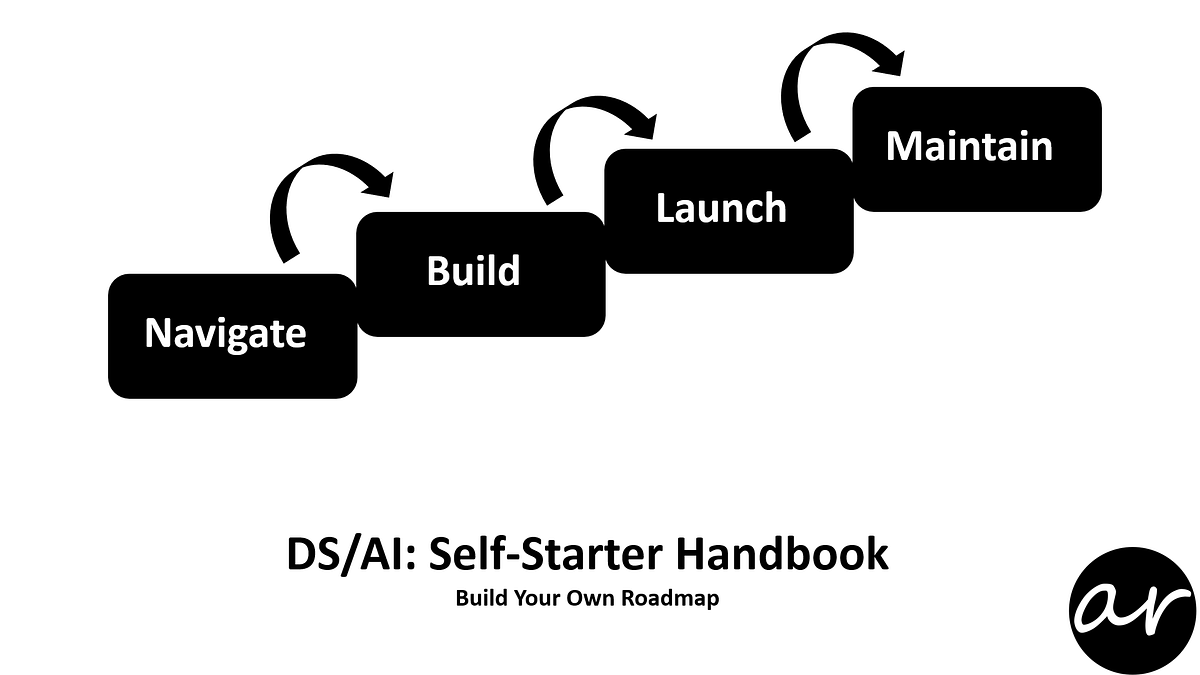Data Science Self-Starter Handbook (Preview)

This is the pilot post of blog post series ‘DS/AI: Self-Starter Handbook’, this post covers the context, table of content & links to upcoming posts of this series topic-wise.
- Why this series?
- What these series cover?
- Who this series is for?
***Table of Content***
- Understanding the Big Picture
- Navigating the Landscape
- Working on Building Blocks
- Utilizing the Resources
- Building your Portfolio
- Networking & Landing the Job
- Making Career Future-Proof
- Putting it All Together
Want to learn more? visit www.ankitrathi.com
It is probably not a secret that data science/artificial intelligence (DS/AI) has become one of the most exciting fields of this age. Although it may seem the buzzword of our time, it is certainly not the hype. This exciting field opens the way to new possibilities and is becoming indispensable to our daily lives.
Organizations, big or small, are heavily investing in DS/AI research and applications these days. And hence, it has become the hottest career. If you want to become a DS/AI practitioner, there is no better time than this.
Aspirants are taking different approaches to get into the field, some are fortunate enough to be put into projects as freshers, but most aspirants are building their capabilities by learning theory and applying them on public data-sets.
While there is no dearth of free & paid material, too much of information has only confused the current crop of DS/AI aspirants.
Based on the questions that I am asked by them on day to day basis, I can see how perplexed they are. Not to say, taking advantage of the situation, most of the training institutes are minting money like anything, bundling even non-relevant courses as well in data science ones.
Why this series?
From a time around when DS/AI field started picking up, every other day I get at least 8–10 messages from DS/AI starters & enthusiasts on ‘How can I get into DS/AI field?’. Over a while, I have improvised my response based on the follow-up questions they ask like:
- What is the difference between DS, ML, DL, AI, DM?
- What are the roles in DS/AI, who does what?
- What concepts, processes & tools they need to learn?
- Which books, courses, etc they need to refer to?
- How to build a DS/AI portfolio?
- How to write a resume for DS/AI?
- How to build a helpful network?
- How to search for the job?
- How to prepare for the interview?
- How to stay up to date in this still-evolving field?
You can notice that these questions are not conceptual ones and there is no dedicated material to address these roadblocks.
How about a book or course that gives you enough exposure to the DS/AI field that you can yourself analyze what is needed for you and build your own roadmap?
My answer to the above question is this series.
What these series cover?
This series is organized into 9 posts:
Post 1 is the one you are reading right now, it captures the motivation to write this blog series.
Post 2 covers the high-level approach to how you can build your road-map to learn data science & build a career in it.
Posts 3–8 cover all the steps mentioned in chapter 1 in greater depth to give you enough knowledge to build your road-map.
Post 9 guides on how to continue from here, keep yourself updated and remain ahead of the curve in this ever-evolving field.
Who this series is for?
This series can be useful for a variety of readers, but I wrote it with two main target audiences in mind. One of these target audiences is university students learning about DS/AI field, including those who are starting a career in data science and artificial intelligence. The other target audience is professionals working in other fields, who do not have a data science, statistics or programming background but want to rapidly acquire one and expand their career.
There is no assumption or prerequisites for a reader to cover before reading this series.
Looks interesting? Stay tuned to read the upcoming post as soon as it is published.
Ankit Rathi is an AI architect, published author & well-known speaker. His interest lies primarily in building end-to-end AI applications/products following best practices of Data Engineering and Architecture.
Why don’t you connect with Ankit on YouTube, Twitter, LinkedIn or Instagram?
If you have any questions or comments, click the "Go To Discussion" button below!